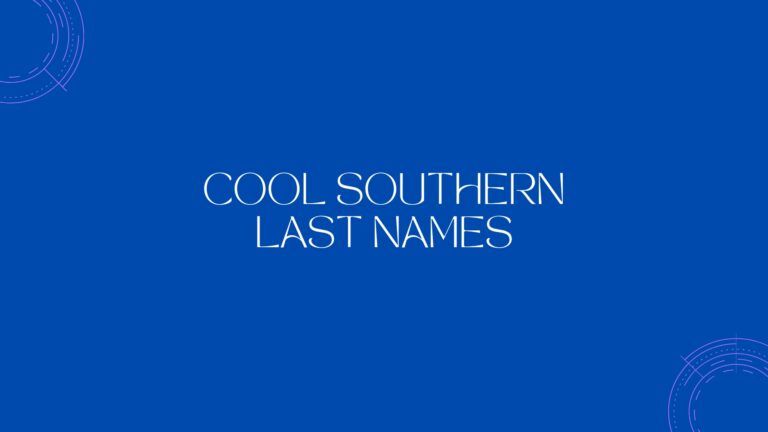100 Cool Japanese Last Names
Japanese surnames are of great interest to me as they represent the cultural history and traditions of the country.
They may derive from nature, geography, or various ancient beliefs; these family names have meanings that go beyond that of mere identification.
From names representing the splendor of nature to names rooted in the family’s ancestry, each tells a different story.
In this blog post, we will analyze the meanings behind some common Japanese last names to discover their history, cultural background, and symbolism.
Japanese last names
Takahashi (高橋) – “Tall bridge”
Yamamoto (山本) – “Base of the mountain”
Tanaka (田中) – “Center of the rice field”
Watanabe (渡辺) – “Crossing the boundary”
Sato (佐藤) – “Help and wisteria” (a type of flower)
Kobayashi (小林) – “Small forest”
Nakamura (中村) – “Middle village”
Inoue (井上) – “Above the well”
Ishida (石田) – “Stone rice field”
Matsumoto (松本) – “Base of the pine tree”
Yoshida (吉田) – “Good rice field”
Shimizu (清水) – “Pure water”
Fujita (藤田) – “Wisteria field”
Hasegawa (長谷川) – “Long valley river”
Kato (加藤) – “Increase wisteria”
Murakami (村上) – “Above the village”
Okada (岡田) – “Hill rice field”
Kawai (川井) – “River well”
Miyamoto (宮本) – “Base of the shrine”
Abe (安倍) – “Peaceful” or “safe” (alternative readings exist)
Ueda (上田) – “Upper rice field”
Oda (織田) – “Weaving rice field”
Fujimoto (藤本) – “Base of the wisteria”
Noguchi (野口) – “Field mouth”
Kurosawa (黒沢) – “Black swamp”
Tominari (富成) – “Rich, prosperous”
Kobayakawa (小早川) – “Small, swift river”
Sekiguchi (関口) – “Boundary mouth”
Yamaguchi (山口) – “Mountain’s mouth”
Nishimura (西村) – “West village”
Sasaki (佐々木) – “Help and tree”
Kishimoto (岸本) – “Base of the shore”
Taniguchi (谷口) – “Valley mouth”
Takeda (武田) – “Military rice field”
Murata (村田) – “Village rice field”
Ono (小野) – “Small field”
Hirano (平野) – “Flat field”
Yokoyama (横山) – “Side mountain”
Sakamoto (坂本) – “Base of the hill”
Arai (新井) – “New field”
Hashimoto (橋本) – “Base of the bridge”
Araki (荒木) – “Rough tree”
Fujii (藤井) – “Wisteria well”
Kuroda (黒田) – “Black rice field”
Shimamoto (島本) – “Base of the island”
Yamagishi (山岸) – “Mountain shore”
Tsuchiya (土屋) – “Earth house”
Asano (浅野) – “Shallow field”
Nakajima (中島) – “Middle island”
Okamoto (岡本) – “Base of the hill”
Kobayashi (小林) – “Small forest”
Sakai (酒井) – “Sake well”
Nakanishi (中西) – “West of the middle”
Kurosaki (黒崎) – “Black cape”
Takagi (高木) – “Tall tree”
Iida (飯田) – “Rice field”
Fukuda (福田) – “Blessed rice field”
Hattori (服部) – “Clothing department”
Miyazaki (宮崎) – “Shrine hill”
Kawashima (川島) – “Island in the river”
Yokota (横田) – “Horizontal rice field”
Ishikawa (石川) – “Stone river”
Seki (関) – “Barrier”
Ono (尾野) – “Tail field”
Uchida (内田) – “Inner rice field”
Sugimoto (杉本) – “Base of the cedar tree”
Nakamura (中村) – “Middle village”
Takahashi (高橋) – “Tall bridge”
Nishida (西田) – “West rice field”
Fujisawa (藤沢) – “Wisteria swamp”
Kawano (川野) – “River field”
Shibata (柴田) – “Brushwood rice field”
Okamoto (岡本) – “Base of the hill”
Ishida (石田) – “Stone rice field”
Matsuda (松田) – “Pine tree rice field”
Kobayashi (小林) – “Small forest”
Kuroda (黒田) – “Black rice field”
Oda (織田) – “Weaving rice field”
Tominari (富成) – “Rich, prosperous”
Abe (安倍) – “Peaceful” or “safe”
Wada (和田) – “Harmonious rice field”
Sakurai (桜井) – “Cherry tree well”
Yamagata (山形) – “Mountain shape”
Yoshimoto (吉元) – “Good origin”
Shiraishi (白石) – “White stone”
Kaneko (金子) – “Child of gold”
Nagasaki (長崎) – “Long cape”
Kawai (川井) – “River well”
Arai (新井) – “New field”
Miyamoto (宮本) – “Base of the shrine”
Tsuchiya (土屋) – “Earth house”
Asano (浅野) – “Shallow field”
Fujimoto (藤本) – “Base of the wisteria”
Iida (飯田) – “Rice field”
Hara (原) – “Plain, field”
Oikawa (大井川) – “Big river”
Yokoyama (横山) – “Side mountain”
Kase (加瀬) – “Add cape”
Ikeuchi (池内) – “Inside the pond”
Saito (斉藤) – “Correct wisteria”







